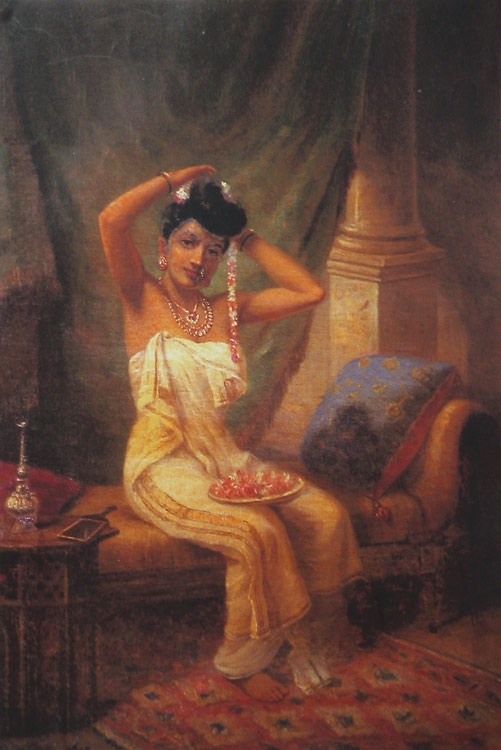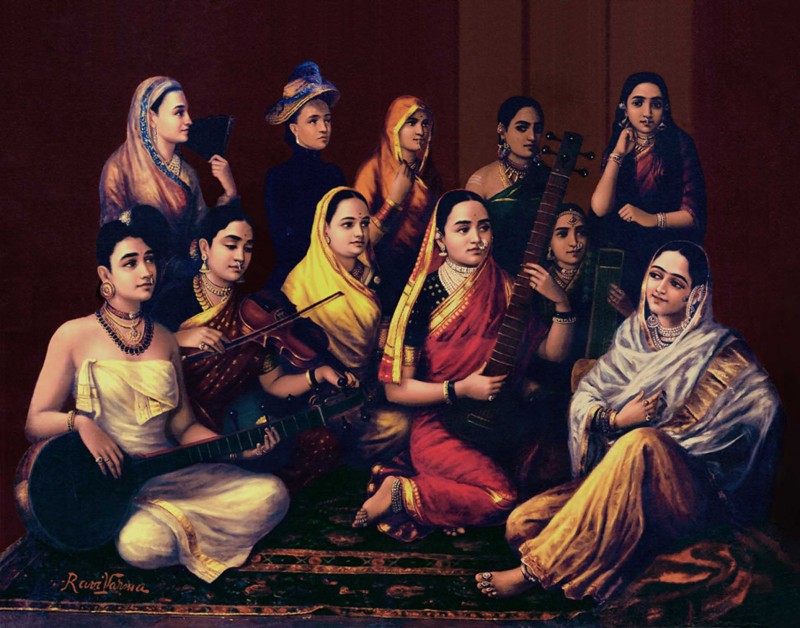Introduction
 |
Raja Ravi Varma, Public domain, via Wikimedia Commons Damayanti and the Swan |
Known for his mastery of oil painting and his role in democratizing art through lithographic prints, Varma redefined the visual culture of modern India.
His paintings continue to captivate audiences worldwide, offering a window into the soul of a country at the intersection of tradition and colonial influence.
This essay delves into his life, his stylistic innovations, his choice of palette and subjects, the models he used, the influence of contemporary art movements, and an analysis of some of his most iconic works.
Life and Education in Art
Raja Ravi Varma was born on April 29, 1848, in Kilimanoor Palace in the princely state of Travancore, now part of Kerala. He belonged to the aristocratic family of the Travancore royal house. His early exposure to art came through temple murals and traditional Kerala paintings. Encouraged by his uncle, Raja Raja Varma, young Ravi began experimenting with natural dyes and charcoal on palace walls.
Recognizing his talent, the Maharaja of Travancore arranged for him to be trained by Rama Swamy Naidu, a painter at the court. Later, he was tutored by a British artist, Theodore Jenson, who introduced him to European techniques like oil painting, perspective, chiaroscuro, and anatomical accuracy. These lessons would become foundational to Varma’s signature style. In 1873, Varma gained national recognition by winning an award at the Madras Fine Arts Exhibition. His fame only grew after he exhibited his work at the 1893 World’s Columbian Exposition in Chicago.
Style of Painting and Artistic Signature
If a single Indian painter were to be spotlighted, Raja Ravi Varma would undoubtedly be the choice. By his passing in 1906 at 58, he had already cemented his legacy as one of India's greatest artists. The displayed works showcase his masterful ability to convey feminine modesty through vibrant colors and expert brushstrokes, with traditional poses and distinct emotional expressions gracing each canvas.
Initially, Varma honed his skills in watercolor before receiving formal training under a British oil painter. Hailing from the Royal family of Travancore in southern India, he also captured his family members on canvas. Notably, two featured portraits depict his sister-in-law, Rani Lakshmi Bayi of Travancore.
|
|
|
Raja Ravi Varma's art style is best described as a fusion of European academic realism and Indian aesthetics. He was among the first Indian artists to adopt oil painting, a medium traditionally uncommon in India. With this medium, he skillfully rendered three-dimensional forms, naturalistic light and shadow, and accurate anatomy, while portraying subjects deeply rooted in Indian ethos.
Varma paid meticulous attention to detail, often focusing on the textures of skin, fabrics, and jewelry. His use of light mimicked European masters like Rembrandt and Caravaggio. What distinguished Varma was his ability to humanize divine figures, portraying gods and goddesses with emotive expressions, realistic proportions, and relatable postures. This approach made the divine accessible, a revolutionary concept in Indian visual culture.
Choice of Palette
Varma's palette was a reflection of his dual influences. He used earthy tones, soft browns, beiges, and muted greens for rural and domestic scenes. For mythological themes, his palette turned vibrant, with reds, golds, deep blues, and bright whites to depict grandeur and divinity. His skill in mixing colors helped him create luminous skin tones, lifelike drapery, and rich textures that brought his subjects to life.
He often juxtaposed warm and cool tones to create contrast and depth. For instance, in religious scenes, the divine figures would glow in warm tones, set against cooler, subdued backgrounds. His color choices not only enhanced the visual appeal but also served symbolic purposes, elevating the narrative power of his works.
Models and Inspirations
Varma often used women from his own community and surroundings as models. His muses included courtesans, aristocratic women, and occasionally, family members. These women posed for a range of divine and mortal characters. One of his most famous muses was Sugandha Bai, a woman of remarkable beauty who modeled for several of his works.
His models were chosen not just for their physical beauty but also for their ability to express emotion and posture as required by the subject. Through them, Varma introduced a new visual archetype of Indian womanhood: graceful, sensuous, yet dignified. His depiction of women influenced Indian cinema, advertisements, and popular iconography for decades.
Subjects of His Paintings
Paper Jewels, CC BY 4.0, via Wikimedia Commons Gangavataran |
He portrayed gods like Vishnu, Krishna, and Shiva, goddesses like Lakshmi and Saraswati, and epic heroines like Draupadi and Sita. Importantly, he gave these mythological figures a human form, grounded in reality, which allowed people to relate to them on a personal level. His art offered a visual literacy to a largely illiterate population, contributing to the spread of nationalist and cultural identity during the colonial era.
Influence of Contemporary Art Movements
Although Varma was self-taught in many respects, his work was heavily influenced by European academic art, especially from the Renaissance and Baroque periods. The realism of European masters, use of linear perspective, and chiaroscuro techniques found echoes in his works. The British colonial presence in India exposed him to Victorian aesthetics and salon-style portraiture.
He was also influenced by the Bengal School of Art, albeit indirectly. While the Bengal School later reacted against Western techniques, Varma embraced them. This contrast eventually led to debates about authenticity, nationalism, and artistic integrity. Despite criticism from modernists like Abanindranath Tagore, Varma’s works remained immensely popular among the general public.
His establishment of the Ravi Varma Press in 1894 was a visionary move. It mass-produced oleographs of his paintings, making art accessible to middle-class homes across India. This not only revolutionized art consumption but also laid the groundwork for India’s visual culture in the 20th century.
Analysis of Seven Iconic Paintings

Raja Ravi Varma, Public domain,
via Wikimedia Commons
1. Nair Lady Adorning Her Hair (1873)

Raja Ravi Varma, Public domain,
via Wikimedia Commons
This painting exemplifies Varma's attention to everyday beauty. It depicts a Nair woman seated while arranging her hair, dressed in traditional Kerala attire. The intricate detailing of her jewelry, the softness of her skin, and the realism of the surrounding objects showcase his technical prowess. The painting brought him early fame and a medal at the Madras Fine Arts Exhibition.
Picture a serene moment in a quiet room. A Nair woman, dressed in the traditional white and gold of Kerala, is seated peacefully. Her back is turned to us, and we are privy to a private act of beauty: she is meticulously arranging her long, dark hair. You can almost feel the softness of her skin and the weight of her intricate jewelry.
This painting isn't about grand events; it's a testament to the quiet dignity and grace of everyday life, captured with such realism that it brought the young Raja Ravi Varma his first taste of fame.
2. Shakuntala Patralekhan (1876)
 |
Raja Ravi Varma, Public domain, via Wikimedia Commons |
The painting was purchased by the Duke of Buckingham.
We find ourselves in a lush, dense forest, where the heroine Shakuntala is lost in thought.
3. Galaxy of Musicians (1889)
 |
Raja Ravi Varma, Public domain, via Wikimedia Commons |
Here Raja Ravi Varma had imagined a vibrant tableau of eleven women, a living tapestry of India's cultural diversity. Each woman is dressed in the distinct attire of a different region, from the detailed clothing of Kashmir to the vibrant sari of Bengal.
4. Godohan
 |
Raja Ravi Varma, Public domain, via Wikimedia Commons |
This is a quiet, humble scene that Varma elevates to high art. We see a cowherd woman in a rural setting, gently milking a cow.
The painting's focus is on the quiet dignity of the act and the serene bond between the woman and her animal. It shows Varma's deep respect for rural life and his ability to find profound beauty in the most unassuming moments.
5. Vasantasena
 |
Raja Ravi Varma, Public domain, via Wikimedia Commons |
This work fetched upwards of $350,000 at auction.
In a striking departure, this painting introduces us to Vasantasena, a courtesan from an ancient Sanskrit play. She is adorned in opulent red and gold clothing and lavish jewelry, a clear sign of her wealth and status.
Her gaze, however, is what truly captivates. It's direct, confident, and full of intelligence. Varma masterfully portrays her not just as a figure of allure, but as a complex and fully realized character with wit and independence.
6. Nala and Damayanti
 |
Raja Ravi Varma, Public domain, via Wikimedia Commons |
The figures are rendered with exquisite detail, and the emotional tension is palpable. The use of light and shadow adds depth, enhancing the narrative's drama.
This romantic painting, based on the epic Mahabharata, captures a moment of high drama and emotional tension.
The scene is full of exquisite detail, and Varma’s use of light and shadow highlights the central figures and deepens the narrative.
The emotional weight of her choice is palpable, as Nala stands humbly while the disguised gods look on. It is storytelling at its finest.
7. Portrait of a Woman in Russet and Crimson Sari
An untitled portrait, this work highlights Varma’s mastery in rendering textiles and facial expressions. The woman, possibly an aristocrat, is adorned in a sari with rich crimson hues, her face reflecting poise and quiet dignity. It is considered one of his most accomplished portraits and sold for over $200,000.
While the identity of the woman in this portrait remains a mystery, her presence is undeniable. She is believed to be an aristocrat, and Varma captures her with incredible poise and quiet dignity. The painting is a masterclass in texture and expression—the rich crimson hues and gold borders of her sari are rendered with a startling realism, while the soft light on her face reveals a profound sense of self-possession. It’s a timeless portrait, capturing not just a likeness, but the very soul of its subject.
Market Value and Auction Records
Raja Ravi Varma's works are considered national treasures in India, and original oil paintings rarely come to market. When they do, they fetch enormous prices. In 2019, a rare painting depicting a Travancore scene sold for approximately ₹16.1 crore (about $2 million) at SaffronArt. His painting "Vasantasena" sold for an estimated $350,000, while "Nala and Damayanti" fetched around $150,000. Portraits and lithographs are more accessible; oleographs often sell for $100–$500 depending on rarity and condition.
Collectors prize his works not just for their historical significance but also for their aesthetic and cultural value. Institutions like the National Gallery of Modern Art and private collectors around the world preserve his legacy.
Conclusion
Raja Ravi Varma was not just a painter; he was a cultural phenomenon. His genius lay in marrying the realism of European academic art with the soul of Indian mythology and daily life. His art humanized the divine, democratized visual culture, and left an indelible imprint on India’s artistic imagination. Whether through original oils or mass-produced prints, his works continue to inspire reverence, nostalgia, and artistic aspiration. In many ways, Ravi Varma laid the groundwork for modern Indian art, and his legacy remains vibrant and relevant even in the 21st century.
.jpg)

